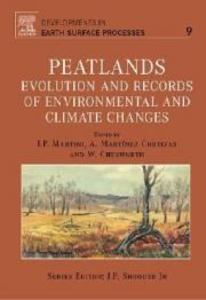Lowland tropical peatlands of Southeast Asia
Page, S.E., Rieley, J.O., and Wüst, R. (2006) Lowland tropical peatlands of Southeast Asia. In: Martini, I.P., Martinez Cortizas, A., and Chesworth, W., (eds.) Peatlands: evolution and records of environmental and climate changes. Developments in Earth Surface Processes, 9 . Elsevier, Netherlands, pp. 145-172.
|
PDF (Published Version)
- Published Version
Restricted to Repository staff only |
||
![[img]](https://researchonline.jcu.edu.au/3610/2.hassmallThumbnailVersion/3610_Page_et_al_2006.jpg)
|
Image (JPEG) (Front Cover)
- Cover Image
Download (9kB) |
Abstract
[Extract] Peatlands are terrestrial wetland ecosystems in which the production of organic matter exceeds its decomposition and a net accumulation results. Several factors influence peat formation and preservation, including a positive climatic moisture balance (precipitation minus evaporation), high-relative humidity, topographic and geological conditions that favor water retention, and low substrate pH and nutrient availability. The majority of the world’s peatlands occur in boreal and temperate zones where they have formed under high-precipitation, low-temperature climatic regimes. In the humid tropics, however, regional environmental and topographic conditions have enabled peat to form under a high-precipitation, high-temperature regime (Andriesse, 1988) and, as a consequence, extensive peatlands occur in southeast Asia, mainland east Asia, the Caribbean and Central America, South America and southern Africa. Most of these are located at low altitudes where rain forest vegetation grows on a thick mass of organic matter accumulated over thousands or tens of thousands of years, to form deposits up to 20m thick (Anderson, 1983). In the tropics, these lowland peatlands are almost exclusively ombrogenous (the peat surface only receives water from precipitation), whereas geogenous peatlands, that are fed additionally by water that has been in contact with the mineral bedrock and soils, are of more limited distribution, being confined to the edges of coastal lagoons, the banks and flood zones of rivers, and the margins of upland lakes. Undisturbed, lowland ombrogenous peatlands support peat swamp forest; freshwater swamp forests are associated with geogenous peatlands.
| Item ID: | 3610 |
|---|---|
| Item Type: | Book Chapter (Research - B1) |
| ISBN: | 978-0-444-52883-4 |
| ISSN: | 0928-2025 |
| Keywords: | peatlands; carbon; carbon cycle; tropical; peat deposits; resources |
| Related URLs: | |
| Date Deposited: | 24 Jun 2009 06:25 |
| SEO Codes: | 96 ENVIRONMENT > 9609 Land and Water Management > 960999 Land and Water Management of Environments not elsewhere classified @ 50% 97 EXPANDING KNOWLEDGE > 970104 Expanding Knowledge in the Earth Sciences @ 25% 96 ENVIRONMENT > 9612 Rehabilitation of Degraded Environments > 961201 Rehabilitation of Degraded Coastal and Estuarine Environments @ 25% |
| Downloads: |
Total: 267 Last 12 Months: 4 |
| More Statistics |



